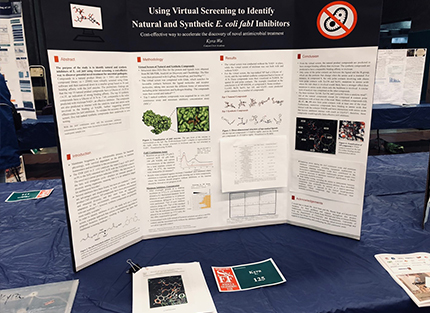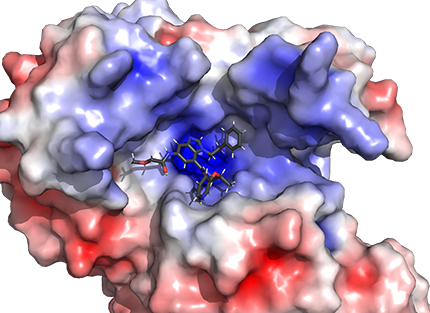UC San Diego Students Share Knowledge that Leads to 11th Grader’s Science Fair Win
March 31, 2020 | By Cynthia Dillon
 Poster board presented by Kyra Wu at the Greater San Diego Science and Engineering Fair (GSDSEF), for which she received 1st place in the Senior Division, Biochemistry and was nominated to go on to the California Science and Engineering Fair (CSEF). Photo courtesy of Terra Sztain-Pedone, UC San Diego Chemistry and Biochemistry
Poster board presented by Kyra Wu at the Greater San Diego Science and Engineering Fair (GSDSEF), for which she received 1st place in the Senior Division, Biochemistry and was nominated to go on to the California Science and Engineering Fair (CSEF). Photo courtesy of Terra Sztain-Pedone, UC San Diego Chemistry and Biochemistry
Making science accessible is a welcome endeavor for UC San Diego PhD student Terra Sztain-Pedone. In her fourth year studying chemistry under the tutelage of Professors Michael Burkart, Andrew McCammon and Rommie Amaro, Sztain-Pedone finds time to pass along what she has learned. So when a student from Canyon Crest Academy in San Diego contacted one of her professors with a research proposal for the 2020 Greater San Diego Science and Engineering Fair (GSDSEF), Sztain-Pedone stepped up.
The aspiring researcher explained that Kyra Wu reached out to McCammon and Amaro seeking assistance on completing a project she designed. Wu proposed performing an in silico (performed on a computer or computer simulation) screening to identify new inhibitors for the antibiotic target protein FabI from Escherichia coli.
“This project was extremely similar to the one I was guiding my undergraduate student Andy Mitchell through. His project involves high throughput virtual screening of inhibitors for the Mycobacterium tuberculosis homolog of FabI, InhA,” detailed Sztain-Pedone. “We were excited to leverage experience from this ongoing work to assist Kyra with her research project. Andy played a large role in relaying the information I taught him to Kyra.”
Sztain-Pedone said that the team was able to express and purify proteins necessary for performing an activity assay on the top five compounds identified from the virtual screen, and compare them to the known FabI inhibitor, triclosan.
“Though the data is still in the preliminary stages, we believe we may have identified more potent inhibitors than triclosan,” said Sztain-Pedone, “and Kyra won first place for the Senior Division in the Biochemistry section at the Greater San Diego Science and Engineering Fair, and she was nominated to go on to the California Science and Engineering Fair (CSEF).”
Wu said that her winning science journey with UC San Diego began last fall when her school-year first started.
“I was part of the Quest Tier II class in Canyon Crest Academy, which promotes independent research. When school started, each member of the class started reading scientific literature and brainstorming ideas. When I found an idea that resonated with me and felt feasible to complete with the limited resources and relatively tight timeframe, I began forming a plan,” said Wu.
Her plan included pre-approval for her project by the science fair officials by mid-November, signing all the necessary forms, and submitting her research idea and methodology. Once she received approval, she began the actual experimentation.
“From roughly the end of November to the beginning of this year, I was learning and working on the virtual screening process. It took a while to figure out since I had to learn how to use tools like Linux, PyMOL and Glide, which is where Terra and Andy came in,” Wu said.
The fair’s screening day was Feb. 12, when students like Wu submitted their projects online. According to first-place winner, an estimated two-thirds of the projects were invited to participate in the fair.
“I had some issues getting the compounds for the experiments, so I didn't start the physical experimentation until the end of February. Since I only had a handful of weeks left, I ended up going to the lab on Friday, Saturday and Sunday for three or four weeks prior to the fair,” Wu explained.
 Antibiotic target FabI from Escherichia coli docked to an inhibitor identified from high throughput virtual screen. Photo by Terra Sztain-Pedone, UC San Diego Chemistry and Biochemistry
Antibiotic target FabI from Escherichia coli docked to an inhibitor identified from high throughput virtual screen. Photo by Terra Sztain-Pedone, UC San Diego Chemistry and Biochemistry
She estimates that she spent about 40 hours on lab work during the last month, becoming familiar with the setting, the tools and running experiments.
“Terra was super helpful with this part, guiding me through the process and teaching the science behind the tests/steps as much as possible,” Wu said.
During the final days leading up to the fair, Wu said she was also busy setting up another test in her school lab and continuing to collect data—all while writing up her final 39-page report, plus setting up the research poster and putting together some talking points.
“I love to see the ripple effect of teaching and mentorship,” said Sztain-Pedone. “Someone taught me how to carry out this project which I was able to teach an undergraduate student, who was able to teach a high school student. So cool! I also enjoy the deeper level of understanding I gain through figuring out how to explain everything in multiple ways until it aligns with an individual’s particular learning style.”
Sztain-Pedone said that she encourages other high school students interested in science to reach out to labs they find interesting.
“Some [labs] may not answer but others will be delighted to hear from someone so eager so early on. It’s never too early to start gaining research experience or insights as to whether research is something you’re interested in,” said Sztain-Pedone.

